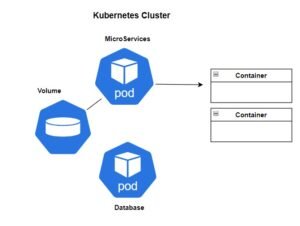Kubernetes services play a role in facilitating communication between various components (such as pods) within a Kubernetes cluster. They provide a consistent way to access applications deployed within the cluster, regardless of the underlying infrastructure or the dynamic nature of the cluster itself.
Here’s a more detailed explanation of Kubernetes services along with a diagram to illustrate their functionality:
What are Kubernetes Services?
In Kubernetes, a service that defines a logical set of pods and a policy by which to access them. It acts as an intermediary between clients and pods, providing a stable endpoint (IP address and port) that clients can use to access the pods, even as pods are added or removed due to scaling, failures, or updates.
Types of Kubernetes Services:
ClusterIP: This is the default type of service. It exposes the service on an internal IP within the cluster, making it accessible only from within the cluster.
NodePort: This type of service will exposes the service on a static port on each node’s IP address. It makes the service accessible externally from outside the cluster.
LoadBalancer: This type of service provisions an external load balancer in the cloud provider’s network, which routes traffic to the service. It’s typically used for exposing services to the internet.
ExternalName: This type of service maps the service to a DNS name (specified by the externalName field), rather than an IP address or port. It allows access to services located outside the cluster.
How Kubernetes Services Work:
When you create a service in Kubernetes, it assigns a stable IP address and port to the service. This IP address is known as the ClusterIP and is accessible from within the cluster.
The service continuously monitors the set of pods it’s responsible for and dynamically updates its endpoint list as pods are added or removed. This ensures that clients always reach an available instance of the application, even if the underlying pods are scaled up or down.
Diagram Illustrating Kubernetes Services
In the diagram:
Pods (Pod 1, Pod 2, Pod 3) represent instances of the application.
The Service abstracts these pods and provides a stable endpoint (ClusterIP:Port) for accessing them.
The external client communicates with the service using the ClusterIP and port.
The service dynamically manages the endpoint list, ensuring that client requests are routed to available pods.
This architecture ensures reliability, scalability, and flexibility in accessing applications deployed within a Kubernetes cluster.
To Read More on Kubernetes Check Below
To Explore More in DevSecOps- Read More :
Roles and Responsibilities of DevSecOps Engineer
DevSecOps Tool-Static Application Security Testing (SAST) tools
DevSecOps Tool-Dynamic Application Security Testing (DAST) Tools
DevSecOps Tool-Software Composition Analysis (SCA) Tools
DevSecOps Tool-Container Security Tools in DevSecOps
DevSecOps Tool-Infrastructure as Code (IaC) security Tools
DevSecOps Tools – Secrets Management Tools
DevSecOps Tools – Vulnerability Management Tools
DevSecOps Tools – Security Orchestration, Automation, and Response (SOAR) Tools
DevSecOps Tools – Security Information and Event Management (SIEM) tools




